For any number of reasons you may need to add, delete or edit DNS records. For instance, you may need to add an MX DNS to handle emails.
Access you DNS records
To access your DNS records:
- Go to your My Elementor dashboard.
- In the top bar, click Domains.
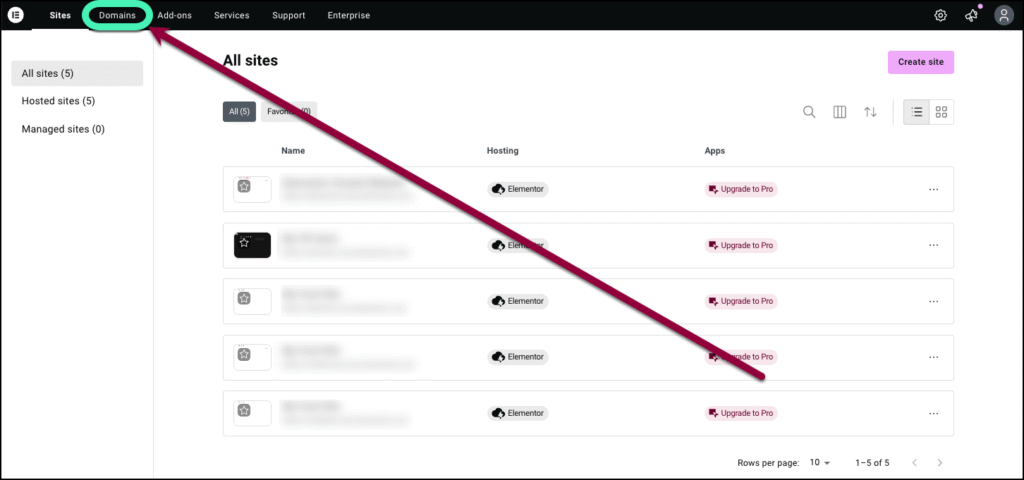
A list of your domains appears.

- Click the domain name associated with the DNS records you want to access.
The Domain overview screen appears.
Note: You can also access the DNS records by:
- Hovering over the domain name you want to access the DNS records for.
- Click the ellipses next to the domain name.
- Select DNS servers from the dropdown menu.
This takes you directly to the DNS servers screen.
Add a DNS record
You can add a number of different DNS types to your domain:
- A
- AAAA
- CNAME
- MX
- SRV
- CAA
- TXT
For details about these DNS types, see What is a DNS record?
To add a DNS record:
- Go to the Domain overview screen as described above.
- Click Manage DNS.
- Click Add Record.
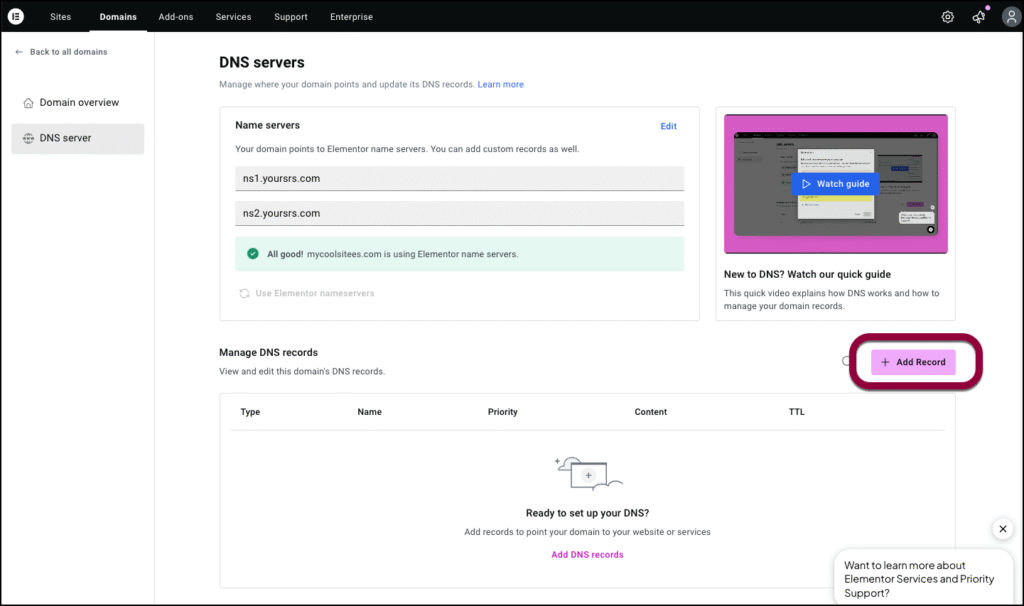
Add an A record
- Use the Type dropdown menu to select A.
In the Name field fill in your domain name. For example, example.com.
(Optional) In the TTL field, you can fill in a Time-To-Live (TTL) value to replace the default value. TTL is the value (in seconds) that tells DNS resolvers how long they should cache (store) the record before checking the authoritative server for a new update.
Fill in your website’s IPv4 address. For example, 192.168.1.1
Click Save to save the record.
Add an AAAA record
If your site uses a version 6 IP address (IPv6), you’ll need to add a AAAA record.
- Use the Type dropdown menu to select AAAA.
- In the Name field fill in your domain name. For example, example.com.
- (Optional) In the TTL field, you can fill in a Time-To-Live (TTL) value to replace the default value. TTL is the value (in seconds) that tells DNS resolvers how long they should cache (store) the record before checking the authoritative server for a new update.
- Fill in your website’s IPv6 address. For example, fd12:3456:789a:1::1
Click Save to save the record.
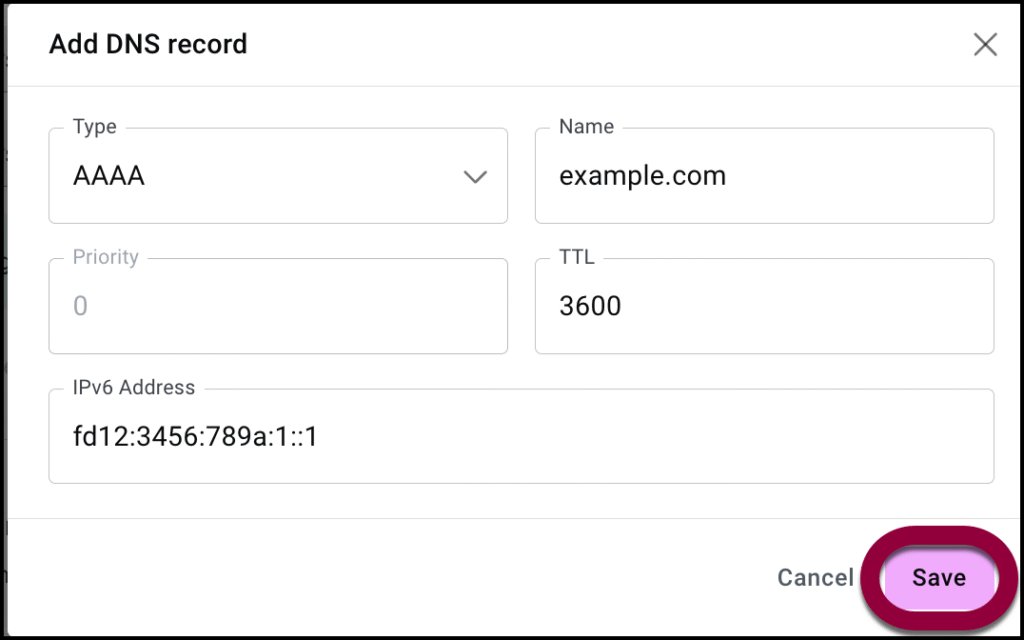
Add a CNAME record
Adding a CNAME record lets users find your site when they type in www before the domain name. For Adding a CNAME record lets users find your site when they type in www before the domain name. For instance, if they enter www.example.com instead of just example.com.
- Use the Type dropdown menu to select CNAME.
- In the Name field fill in the name you want users to be able to use. For example, www.example.com.
- (Optional) In the TTL field, you can fill in a Time-To-Live (TTL) value to replace the default value. TTL is the value (in seconds) that tells DNS resolvers how long they should cache (store) the record before checking the authoritative server for a new update.
- Fill in your website’s canonical or real name. For example, example.com.
Click Save to save the record.
Add an MX record
If your domain is set up to receive email you may need to add an MX DNS record. This MX record specifies the mail server responsible for accepting and routing email messages sent to a domain.
- Use the Type dropdown menu to select MX.
- In the Name field fill in your domain name. For example, example.com.
- (Optional) In the TTL field, you can fill in a Time-To-Live (TTL) value to replace the default value. TTL is the value (in seconds) that tells DNS resolvers how long they should cache (store) the record before checking the authoritative server for a new update.
- Enter the name of your mail server. For example, mail.example.com.
- Click Save to save the record.
Add an SRV record
An SRV DNS record specifies the location, including the hostname and port number, of servers that provide specific services like VoIP or instant messaging for a domain.
- Use the Type dropdown menu to select SRV.
- In the Name field fill in your domain name. For example, example.com.
- (Optional) Use the Priority text box to enter a Priority number. The Priority field is used when you have more than one server providing the same service. For instance, you may have two servers providing VOIP. When visitors access the service, they will be directed to the lower priority server first and if that server is unavailable, will be directed to the next lowest priority server.
- (Optional) In the TTL field, you can fill in a Time-To-Live (TTL) value to replace the default value. TTL is the value (in seconds) that tells DNS resolvers how long they should cache (store) the record before checking the authoritative server for a new update.
- (Optional) Enter a weight for the record. Weight is used when you have more than one server providing the same service. For instance, you may have two servers providing VOIP. When visitors access the service, if two, or more, servers have the same priority, the load will be distributed according to the weight. Weight is based on a ratio – a higher weight value gets more connections). For example, a server with a weight of 60 will take 60% of the load.
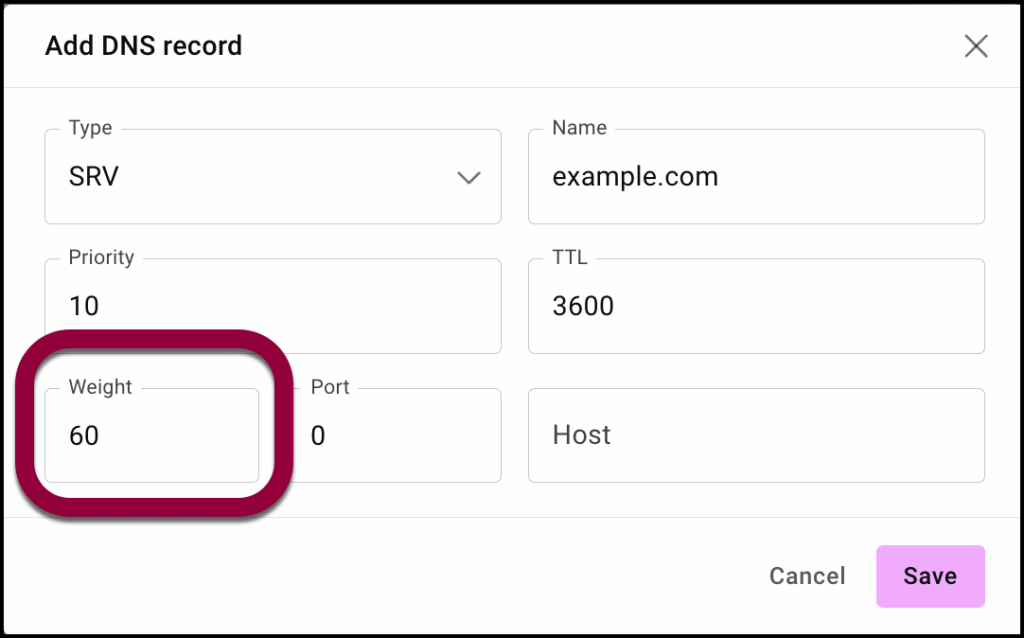
- Use the Port text box to enter the port number that will be used to establish the connection.
- Use the Host textbox to enter the target host’s name. For example, voip-cluster-1.example.com
- Click Save.
Add an CAA record
A CAA DNS record allows a domain owner to specify which Certificate Authorities (CAs) are authorized to issue SSL/TLS certificates for their domain. This can protect your site against fraudulent certificates.
- Use the Type dropdown menu to select CAA.
- In the Name field fill in your domain name. For example, example.com.
- (Optional) In the TTL field, you can fill in a Time-To-Live (TTL) value to replace the default value. TTL is the value (in seconds) that tells DNS resolvers how long they should cache (store) the record before checking the authoritative server for a new update.
- Use the Flag dropdown to set the flag either 0 or 128:
0: Means if a CA encounters a record with a tag it doesn’t recognize or support, it can safely ignore that specific record and proceed with its issuance process based on the other records it does understand.
128: Means the entire CAA record is critical. If a CA encounters a record with this flag set and does not understand the accompanying tag, the CA must stop the certificate issuance process and report a policy violation. - Use the Tag dropdown menu to select a tag for the server:
- Issue: This tag authorizes a specific CA (named in the Value field) to issue specific, non-wildcard, SSL/TLS certificates for the domain.
- Issuewild: This tag authorizes a specific CA (named in the Value field) to issue wildcard SSL/TLS certificates for the domain
- Iodef: This tag provides a reporting mechanism. It specifies a contact endpoint (usually an email address or URL) where a CA should report attempts to fraudulently or incorrectly obtain a certificate for the domain.
- Use the Value text box to enter the parameters for the Flag and the Tag. For example, if you want to give permission to exampleca to issue certificates for example.com without wildcards, you would use the following parameters:
.
- Click Save.
Add a TXT record
A TXT DNS record stores arbitrary text information used primarily for domain verification and configuring email security policies like SPF, DKIM, and DMARC..
- Use the Type dropdown menu to select TXT.
- In the Name field fill in your domain name. For example, example.com.
- (Optional) In the TTL field, you can fill in a Time-To-Live (TTL) value to replace the default value. TTL is the value (in seconds) that tells DNS resolvers how long they should cache (store) the record before checking the authoritative server for a new update.
- Use the Content text box to enter the desired text. For example “google-site-verification=abcdef1234567890” for Google verification.
- Click Save.
Edit or delete a DNS record
You may need to edit a DNS record, for instance if you need your domain to point to a different server.
To edit or a DNS record:
- Go to your My Elementor dashboard.
- In the top bar, click Domains.
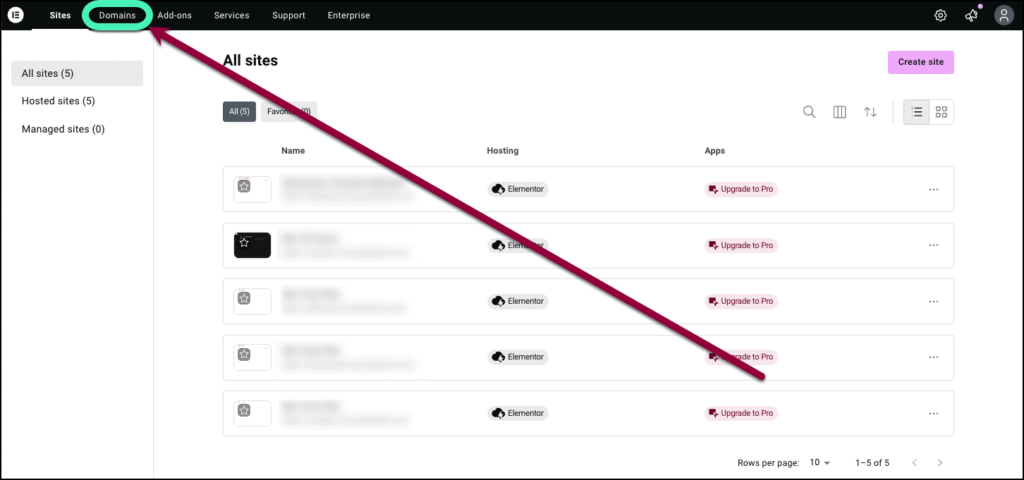
A list of your domains appears.
- Click the domain name you want to edit or delete.
The Domain Overview appears.
- Click Manage Domains.
The DNS servers screen appears. - Scroll down to the Manage DNS records section.
- Click the ellipses to the right of the domain name.
- Select Edit from the dropdown menu to edit the record.
- Select Delete to delete the record.
Note: If you’re deleting a record, you’ll need to confirm your selection.

